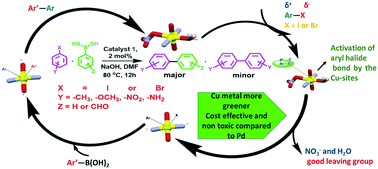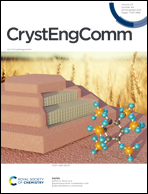A tryptophan-based copper(ii) coordination polymer: catalytic activity towards Suzuki–Miyaura cross-coupling reactions†
Abstract
Herein, we report the synthesis and crystal structure determination of a new Cu(II) coordination polymer (CP) with the formula [Cu(L-tryp)(azpy)1/2(H2O)(NO3)]∝ (CP1), which exhibits an unusual tryptophan coordination mode with copper(II) via carboxylate monodentate binding as well as chelation via Namino and Ocarbonyl groups. CP1 was prepared using the ligand L-tryptophan (L-tryp) and the co-ligand 4,4′-azopyridine (azpy), adapting the mixed-ligand approach and a solvothermal protocol. Single crystal X-ray structural analysis revealed that in CP1, Cu(II) sites show a distorted octahedral geometry, wherein the ligand L-tryp is coordinated through the carboxylate and amine groups, whereas the co-ligand azpy is coordinated to Cu(II) ions through the Npyridyl atom and thus maintains a distorted octahedral geometry around the Cu(II) ions. FT-IR and EPR spectra were also recorded to corroborate the structural analysis. Finally, CP1 was employed as a heterogeneous catalyst for the Suzuki cross-coupling reaction and afforded ∼98% yield under normal reaction conditions.

- This article is part of the themed collections: Host‒Guest chemistry: in honour of Luigi Nassimbeni’s 9th decade and Coordination Networks


 Please wait while we load your content...
Please wait while we load your content...